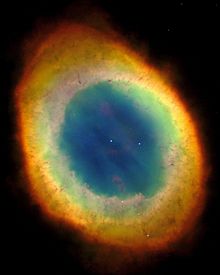Emission nebula: Difference between revisions
m Reverted edits by 66.203.38.207 (talk) to last version by ClueBot NG |
No edit summary |
||
| Line 12: | Line 12: | ||
The nebula's color depends on its chemical composition and degree of ionization. Due to the prevalence of [[hydrogen]] in interstellar gas, and its relatively low energy of ionization, many emission nebulae appear red due to the strong emissions of the [[Balmer series]]. If more energy is available, other elements will be ionized and green and blue nebulae become possible. By examining the [[Electromagnetic spectrum|spectra]] of nebulae, astronomers infer their chemical content. Most emission nebulae are about 90% hydrogen, with the remainder [[helium]], [[oxygen]], [[nitrogen]], and other elements. |
The nebula's color depends on its chemical composition and degree of ionization. Due to the prevalence of [[hydrogen]] in interstellar gas, and its relatively low energy of ionization, many emission nebulae appear red due to the strong emissions of the [[Balmer series]]. If more energy is available, other elements will be ionized and green and blue nebulae become possible. By examining the [[Electromagnetic spectrum|spectra]] of nebulae, astronomers infer their chemical content. Most emission nebulae are about 90% hydrogen, with the remainder [[helium]], [[oxygen]], [[nitrogen]], and other elements. |
||
| ⚫ | |||
Some of the most prominent emission nebulae visible from the [[northern hemisphere]] are the [[North America Nebula]] (NGC 7000) and [[Veil Nebula]] NGC 6960/6992 in [[Cygnus (constellation)|Cygnus]], while in the south celestial hemisphere, the [[Lagoon Nebula]] M8 / NGC 6523 in [[Sagittarius (constellation)|Sagittarius]] and the [[Orion Nebula]] M42.<ref>{{cite web|url=http://messier.seds.org/m/m042.html|title=Messier 42|author=McArthur, Frommert, and Kronberg|date=12 April 2006|work=Messier Object 42|accessdate=17 July 2007}}</ref> Further in the southern hemisphere is the bright [[Carina Nebula]] NGC 3372. |
Some of the most prominent emission nebulae visible from the [[northern hemisphere]] are the [[North America Nebula]] (NGC 7000) and [[Veil Nebula]] NGC 6960/6992 in [[Cygnus (constellation)|Cygnus]], while in the south celestial hemisphere, the [[Lagoon Nebula]] M8 / NGC 6523 in [[Sagittarius (constellation)|Sagittarius]] and the [[Orion Nebula]] M42.<ref>{{cite web|url=http://messier.seds.org/m/m042.html|title=Messier 42|author=McArthur, Frommert, and Kronberg|date=12 April 2006|work=Messier Object 42|accessdate=17 July 2007}}</ref> Further in the southern hemisphere is the bright [[Carina Nebula]] NGC 3372. |
||
| Line 20: | Line 18: | ||
Many nebulae are made up of both [[Reflection nebula|reflection]] and emission components such as the [[Trifid Nebula]]. |
Many nebulae are made up of both [[Reflection nebula|reflection]] and emission components such as the [[Trifid Nebula]]. |
||
==Gallery== |
|||
<gallery> |
|||
The glowing gas cloud LHA 120-N55 in the Large Magellanic Cloud.jpg|Emission nebula [[LHA 120-N55]] in the [[Large Magellanic Cloud]].<ref>{{cite web|title=A Beautiful Instance of Stellar Ornamentation|url=http://www.eso.org/public/news/eso1616/|accessdate=19 May 2016}}</ref> |
|||
| ⚫ | |||
</gallery> |
|||
==References== |
==References== |
||
Revision as of 10:55, 19 May 2016
This article has multiple issues. Please help improve it or discuss these issues on the talk page. (Learn how and when to remove these messages)
|

An emission nebula is a nebula formed of ionized gases that emit light of various colors. The most common source of ionization is high-energy photons emitted from a nearby hot star. Among the several different types of emission nebulae are H II regions, in which star formation is taking place and young, massive stars are the source of the ionizing photons; and planetary nebulae, in which a dying star has thrown off its outer layers, with the exposed hot core then ionizing them.
General information
Usually, a young star will ionize part of the same cloud from which it was born although only massive, hot stars can release sufficient energy to ionize a significant part of a cloud. In many emission nebulae, an entire cluster of young stars is doing the work.
The nebula's color depends on its chemical composition and degree of ionization. Due to the prevalence of hydrogen in interstellar gas, and its relatively low energy of ionization, many emission nebulae appear red due to the strong emissions of the Balmer series. If more energy is available, other elements will be ionized and green and blue nebulae become possible. By examining the spectra of nebulae, astronomers infer their chemical content. Most emission nebulae are about 90% hydrogen, with the remainder helium, oxygen, nitrogen, and other elements.
Some of the most prominent emission nebulae visible from the northern hemisphere are the North America Nebula (NGC 7000) and Veil Nebula NGC 6960/6992 in Cygnus, while in the south celestial hemisphere, the Lagoon Nebula M8 / NGC 6523 in Sagittarius and the Orion Nebula M42.[1] Further in the southern hemisphere is the bright Carina Nebula NGC 3372.
Emission nebulae often have dark areas in them which result from clouds of dust which block the light.
Many nebulae are made up of both reflection and emission components such as the Trifid Nebula.
Gallery
References
- ^ McArthur, Frommert, and Kronberg (12 April 2006). "Messier 42". Messier Object 42. Retrieved 17 July 2007.
{{cite web}}: CS1 maint: multiple names: authors list (link) - ^ "A Beautiful Instance of Stellar Ornamentation". Retrieved 19 May 2016.
- ^ "Hubble revisits the Monkey Head Nebula for 24th birthday snap". ESA/Hubble Press Release. Retrieved 10 April 2014.

![Emission nebula LHA 120-N55 in the Large Magellanic Cloud.[2]](http://upload.wikimedia.org/wikipedia/commons/thumb/9/9a/The_glowing_gas_cloud_LHA_120-N55_in_the_Large_Magellanic_Cloud.jpg/114px-The_glowing_gas_cloud_LHA_120-N55_in_the_Large_Magellanic_Cloud.jpg)
![Hubble image of emission nebula NGC 2174.[3] ]]](http://upload.wikimedia.org/wikipedia/commons/thumb/6/62/New_Hubble_image_of_NGC_2174.jpg/120px-New_Hubble_image_of_NGC_2174.jpg)